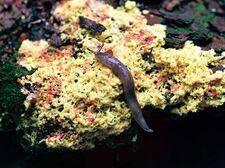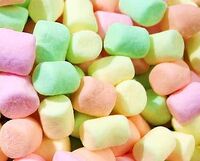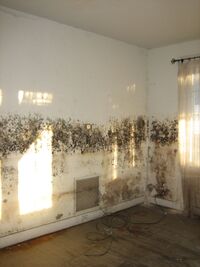Mold
| Mold | |
|---|---|
 | |
| Scientific classification | |
| Kingdom | Animalia |
| Class | Serpentes |
| Order | Foodus |
| Family | Neglectus |
| Species | Foodus Neglectus |
| Binomial name | |
| Afro Asps | |
| Specifications | |
| Weight | Variable |
| Length | Increases over time |
| Special attack | Lung cancer |
| Conservation status | |
| Non-endangered | |
Mold is a miraculous artificial life form. Without mold, society as we know it would not exist today. One can find mold in such environments as rotting produce, unmaintained apartments, Petri dishes, and Jell-O.
Invention
Mold was invented during the Cold War by NASA as part of a rivalry with the Soviet Space Program. Its level of wild success is clearly indicated by the fact that nobody can remember what the Russians were working on at the time in response to it, though some speculate that their project turned into the relatively unremarkable Sputnik.
An initial prototype batch of mold was shipped to a secret testing facility in Denbighshire for a safety evaluation. Unfortunately, a canister containing the life form was accidentally dropped during the unloading process. The kinetic shock caused the contents to a splode, releasing all the mold into the surrounding environment. The experimental mold rapidly reproduced, covering the entire facility and forming the origin of all wild mold species.
Clean-up was deemed too risky due to the possibility of an enormous a splosion, so the facility was buried underground with the help of Area 51 and Hooker Chemical specialists, and a town called Mold was built on top to avoid arousing suspicion from the general public. The town is actually a cover-up for a new monitoring station built on top, where scientists keep watch on the mold cluster below and the rate at which it sends its spores into the environment. The area's operations are kept quiet by the government, meaning it is not even officially listed as a town one can visit, and it is considered dull as a result.
Biology
Mold is actually comprised of numerous smaller organisms which form a visible colony. Upon closer inspection with a microscope, one can discern mold to be a large collection of tiny asps wearing afros (hence mold's fuzzy appearance). These asps are actually quite fashionable, and they spend nearly all of their time restyling their hair; this gives us the wide variety of sizes, shapes, colors and flavors of mold available today.
Slime mold
Sometimes the asps can collectively catch a cold and start swimming in their own snot. At this point, they become a slime mold, and develop a high enough collective intelligence to start planning for world conquest. Slime mold is not to be confused with Silly Putty, which is a type of fungus.
Water mold
Mold asps can not only swim in snot, but regular water, as well. Some of them prefer the water to dry land, donning microscopic scuba gear and pretending to be Jacques Cousteau. These molds are called water molds, although some prefer the fancier term "oomycetes", meaning "moldy eggs". They were originally classified as protists, but this was later corrected to algae. They are best known for promoting healthy growth in plants and providing the taste of flavored water beverages.
Applications
Food industry
Thanks to the wide variety of colors, flavors and textures which mold comes in, it has revolutionized the modern food industry. Consumers today typically want to avoid anything which contains artificial ingredients; since mold has long since its invention been released into the wild, food manufacturers can use it in food classified as "naturally flavored" by the FDA.
The sweet, fruity flavors many mold species possess, in addition to their bright colors, make them an appealing addition to many brands of candy consumed by children worldwide. A Three Musketeers bar is actually a bar of mold coated in a chocolate shell. Marshmallows are made entirely of a type of white mold allowed to go stale, contrary to popular belief. Pop Rocks are hard candy which contain individual microscopic "jail cells" housing mold asps in solitary confinement; the breakdown of the candy walls by saliva causes these asps to go crazy about freedom and a splode.
Mold is a crucial ingredient in moldy cheese. This food is considered a delicacy amongst cheese connoisseurs, enjoyed by adventurous eaters and those clever enough not to become prey to it.
Some food manufacturers package mold in with their product without labeling this on the container; this is done primarily for promotional purposes or to test their consumer hotline.
Pharmaceuticals
Penicillin is an antibiotic which was discovered by Alexander Fleming.[citation needed] However, the process by which it was discovered is fraught with myths and misconceptions, even in academia. It was not until relatively recently that the true origins of this wonder drug were uncovered by historians. Fleming was tending his garden just outside of his laboratory when he noticed that there were a number of a sploded small animals surrounding his vegetables. He closely examined the plants they were consuming when he noticed that a number of his tomatoes had glowing blue fuzz protruding from them. The substance it produced had produced an effect similar to an extreme kitten huffing high in the animals right before they were subatomically obliterated from the sheer awesomeness of it. Fleming excitedly tried some for himself, and was altogether disappointed when he did not achieve anything close to it. However, it did cure his cold (later determined to be the effect of the mold asps latching onto the viruses and a sploding violently), so he figured it was worth writing about in the footnote of another study he was conducting at the time. Thus, penicillin was discovered, and it became immediately useful for its ability to brutally murder anything smaller than a Lolcat in body mass.
As penicillin attracted the attention of the medical community, many other scientists were inspired by Fleming's discovery to find other useful substances from molds. A variety of beneficial compounds were found in this manner.
Interior decoration
Mold is an important decorative element of living quarters. It can add a splash of vibrance to any room, particularly basements and attics. The most popular kind is black mold, which lends a subtle and refined look to any room where the decorator desires a touch of inexpensive glamor.
The fuzzy texture of mold in the home has numerous benefits. It lends a soft feel to walls, which helps cushion one from the impacts experienced when adding other fixtures for a hip, modern look. The afros also act as a microscopic air filter to remove impurities and improve indoor air quality. For this reason, mold is also trivial to maintain; it is essentially self-cleaning as it consumes these impurities, and it can even expand along the wall's surface to create larger, more intricate art pieces without the need to buy anything additional.
The maker of Chia Pets has announced they will soon release a new version of their product which uses mold instead of the plants it normally comes with, making them perfect for air gardens and low-light growing conditions.
Carpet is a particularly hardy and sturdy variety of mold, grown in sheets and laid down like sod during construction or renovation.
Research and development
NASA continues to research mold and create new varieties of it in government-funded research studies. The creation of velcro was inspired by mold, but it is considered inferior by some within the scientific community on account of not being as edible. A more recent invention was memory foam, which is a type of mold that can remember where it was touched at.
Mold played a critical role in the discovery of mouldy bread, which is considered to this day an important advancement in the field of mathematics.
See also
| Featured version: 19 November 2013 | |
| This article has been featured on the main page. — You can vote for or nominate your favourite articles at Uncyclopedia:VFH. | |


